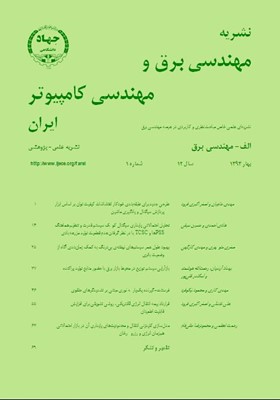طرحی جديد برای طبقهبندی خودکار اغتشاشات کيفيت توان بر اساس ابزار پردازش سیگنال و یادگیری ماشین
محورهای موضوعی : مهندسی برق و کامپیوترمهدي حاجيان 1 , اصغر اکبری فرود 2
1 - دانشگاه سمنان
2 - دانشگاه سمنان
کلید واژه: مونيتورينگ کیفیت توان تشخیص الگو انتخاب ویژگی تحلیل زمان- فرکانسی تبدیل موجک گسسته تبدیل S هذلولی,
چکیده مقاله :
تشخیص و دستهبندی اغتشاشات کیفیت توان یکی از وظایف مهم در حفاظت و نظارت سیستمهای قدرت امروزی است. در حال حاضر اهمیت اصلی، بهبود روشهای تشخيص و طبقهبندي خودکار شكل موجها به کمک يك الگوريتم مؤثر ميباشد. در این مقاله روشی مؤثر برای استخراج ویژگی بر اساس ترکیب تبدیل S هذلولی و موجک ارائه شده است. انتخاب و كاهش ويژگي، موجب كاهش زمان آموزش ميگردد و در بیشتر موارد افزايش ميزان دقت در طبقهبندي دادهها را به همراه دارد. در این مقاله، روشی جديد به نام گرام- اشمیت براي انتخاب ويژگي به کار گرفته شده و همچنین از ساختار طبقهبندی کننده مشهور ماشین بردار پشتیبان چندکلاسه استفاده شده است. همچنین پارامترهای متغیر این طبقهبندی کننده با استفاده از الگوریتم ابتکاری بهينهسازي گروهي ذرات، بهینه شده است. 6 اغتشاش منفرد و 2 اغتشاش ترکیبی و همچنین حالت نرمال برای طبقهبندی در نظر گرفته شدهاند. حساسیت روش پیشنهادی تحت شرایط مختلف نویزی با سطوح مختلف سیگنال همراه با نویز بررسی شده است. همچنین با مقایسه نتایج این مقاله با نتایج مقالات دیگر، کارامدی روش پیشنهادی مورد بررسی قرار گرفته است.
Identification and classification of power quality disturbances (PQDs) are one of the most important functions of monitoring and protection of modern power systems. One of the most important issues in PQ analysis is automatic diagnosis of waveforms using an effective algorithm. This paper presents an effective method, for extracting features, using integration of discrete wavelet transform (DWT) and hyperbolic S transform (HST). Moreover, an efficient feature selection method namely Orthogonal Forward Selection (OFS) by incorporating Gram Schmidt (GS) procedure and forward selection is applied for selection of the best subset features. Multi support vector machines (MSVM), as famous classifier, is applied. Also, the variable parameters of the classifier are optimized using a powerful method namely particle swarm optimization (PSO). Six single disturbances and two complex disturbances as well pure sine (normal) selected as reference are considered for the classification. Sensitivity of the proposed expert system under different noisy conditions is investigated. Also, efficiency of the proposed methods by comparing the results of this study with the results of other papers is examined.
